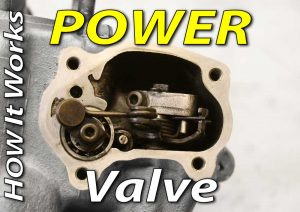
 What Is a 2-Stroke Power Valve?
What Is a 2-Stroke Power Valve?
A 2-stroke power valve is nothing more than a piece of metal slid into the engine’s exhaust port. Its primary function is to regulate the size of the exhaust port, thus enabling the engine to deliver controlled power throughout the rev range.
Back in the day, two-stroke engines had very limited power bands. For example, a 2-stroke utility ATV power band would be tuned to produce a good amount of power in the low-to-mid RPMs. An old motocross 2-stroke powerband would be tuned for the mid-to-upper-high RPM power. Still, another might kick in only at the top-most range. There was almost no in-between.
But then the power valve was introduced to the two-stroke engine, and everything changed.
Today, several types of power valves exist, but mechanical and electrical are the majority. The engine’s speed controls the mechanical valves. Electrical valves come equipped with electrical controls that allow more control over the opening and more precise tuning.
How Does It Regulate The Power?
The power valve’s primary function is to regulate the size of the exhaust port. This regulation in volume will directly influence the position of the power band in the RPM range. The most basic explanation is if the size of the exhaust port is smaller, the exiting airflow is restricted. This restriction will reduce the power potential of the engine. When the exhaust port is open, more air can flow, and the engine can make more power.
The term “on the pipe” means you are getting all the power your bike can make. Getting on the pipe requires the engine RPM and the timing of the exhaust pulses in the expansion chamber to be in perfect sync. What RPM the power hits depends on your exhaust valve and expansion chamber configuration.
Regardless of the type of the two-stroke dirt bike engine, the power valve will close at low RPMs and open at high RPMs. The way it achieves this is via the valve’s governor. The governor overpowers the spring pressure keeping the flap closed and regulates the flap from closed to completely open, depending on engine speed and RPM.
One of the significant advantages of having a power valve in a two-stroke engine is that it allows the engine to produce much more power throughout a broader RPM range. Even more, these valves can be manually adjusted to fine-tune the amount of response you receive at different RPM and throttle position.
As I mentioned earlier, the valve has its spring. That spring can be adjusted, either manually or electronically, to change its tension. That tension change will have different effects on how the power distributes across the rev range.
Keep Your Dirt Bike Maintained!
With advancements in material and engineering, power valve systems seem to be getting more and more durable. The two-stroke power valve is still susceptible to damage. Therefore, it’s essential you know what some of the major causes are for power valve malfunction and damage.
One of the leading causes of power valves failing is the lack of proper maintenance on the components. These parts are in direct contact with exhaust gases and build up carbon quickly, so you need to clean them regularly. A good rule of thumb is to clean and readjust the mechanism (if required) every seven to fifteen running hours.
Two other common causes of power valve failures are backfiring and improper torque levels (too tight or too loose).
It’s also important to note that some valves can malfunction right out of the factory, so make sure you check it before installation and perform a test run after installation.
The most noticeable symptom of a malfunctioning power valve is a complete lack of power at high RPMs. Keep that in mind the next time you can’t make it up that hill!
If you have any questions or anything to add, please leave them in the comments or on our FaceBook page!
Keep Reading – What Octane Rating Do You Need?

